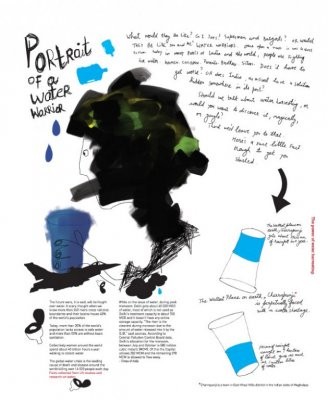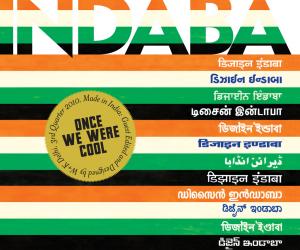First Published in

It has just started raining in New Delhi, capital of India. Two related news pieces were published in Delhi newspapers, on 7 July 2010:
Large part of the city was waterlogged due to rain.
East Delhi residents got into a riot over lack of water.
Same day, same city. Are we missing something?
This narrative is meant to illustrate “W” for water. I wish I had “R” too, for rain.
What is water without rain? Modernity has created a great disconnect between rain and water, in our consciousness, especially amongst urban privileged citizens. Water is meant to come through pipes, through faucets, sometimes hot, sometimes cold. But for a large amount of people, it never appears. Pipes are for rusting, and they separate us from nature.
What caused a water riot and water-logged Delhi at the same time? It rained in Delhi anyway. But the whole urban area is paved with concrete; water cannot reach the soil anymore. What was meant to be a storm water channel is now used to carry sewage. Hence, a sudden shower is extra water that cannot be handled by the channel anymore. Also, all the conduits and pipes are blocked with plastic and other rubbish. So manna from heaven is wasted, mixed with dirt and sewage and poured into the Yamuna River. Mathura, the next town downstream will have to spend a lot of money to clean that water for its residents to use. And Delhi is the capital, and powerful. So it gets its water from Tehri Dam in the Himalayas, 300 kilometres away.
That is exactly what big cities are doing. Chennai gets its water from Veeranam Lake, 230 kilometres away. Bangalore gets it from Kaveri, 100 kilometres away. They get their water from as far away as possible. No wonder urban folk do not respect rain and water. The urban thirst has created a major flashpoint around the water divide. Cities are actually taking away rural water. There are routine water riots.
When the cities cannot manage with long distance water, they dig down and start drawing groundwater. Groundwater mining, for domestic, industrial and agricultural use has turned a major part of the country into a dark zone, with the severe depletion of groundwater. The rampant groundwater usage is considered highly imprudent by the environmentalists, as it is tapping into our only reserve of water for the future, when other sources of clean water will be exhausted.
I first experienced the urban-rural difference in attitude towards water about 12 years ago. I went to meet Ran Singh, a villager in Churu district in Rajasthan, who was awarded by the then President of India as one of India’s great water engineers. He is an expert Kund maker, a local water harvesting structure. I watched him looking up to the cloudless sky in respect every time he talked about water. That’s where the difference is. We, in the cities, look down; bore wells and submersibles do our job.
It is a clichéd example, but makes sense. Jaisalmer, in Rajasthan, has an annual average rainfall of 100 – 200 millimetres, and is a thriving urban centre. On the other hand, Cherrapunji in Meghalaya, with the highest rainfall in the world – 15 000 millimetres annually – is today a location suffering from water scarcity. How did this happen?
Historians acknowledge that Indians have been great water harvesters. It is true, as it is of any old civilization, whether in Africa or in South America. It was all about understanding local ecological limitations, soil, gradients of land, rainfall patterns and creating a culture around it.
The Indian experience is fascinating as the large country has various ecoregions. It has mountains, coasts, river plains and deserts. Each region had multiple solutions for water management, capturing its rainfall endowment intelligently to extend its bounty into the full year. These technologies were administrated locally in a democratic way, and not controlled by the elite. There is nothing religious about water. It is just ecological prudence, and economic reality was based on it. Rajasthan, with its scant rainfall, has the highest number of traditional systems in place and that is how the Western part of the state became a thriving livestock economy.
There is enough evidence to show that community consultations were held to determine crop patterns depending on water availability. That was the way things worked until modernity crept in.
We now have the habit of ignoring ecological reality. We make canals, to show that water can be made to travel in a straight line, and also to demonstrate our power to do so. We can decide who gets the water and who doesn’t. The Rajasthan canal is a case in point. We made a canal to take water into the desert. In anticipation, we got farmers to settle there. But we failed to bring the water into the desert, and all the stagnant water in the area turned a previously dry zone in a malaria-prone region. Every year, there is a water riot. In the process, the old livestock economy is also dead. It is against common sense to promote water-guzzling crops in a water-scarce area. But we tried to do that.
The future is bleak. Water is diminishing. We need land to hold water and every bit of land and water body is seen as a potential building opportunity. Also, the quantity of water is a function of quality. There may be enough polluted water but that is not fit for consumption. It is getting increasingly expensive to deliver clean water. There is also misplaced concern over pricing water. Activists fail to realise that water may be free, but takes immense capital and running costs to gather, clean, pump and deliver that free water. The price of water is not increased in the name of poor people, but poor people are always out of the organised supply network. So middle class and rich people, who use more water and create more wastewater – which is again subsidised by all to clean up – are the ones who enjoy cheap water. If true economic sense is applied, polluters will have to pay for cleaning up. The water price for industry still remains very low, triggering wastage and pollution.
As water sources dry up, there are contesting claims on that diminishing water.
While India aims for higher economic growth and increasing urbanisation, industrial and urban domestic demand for water is skyrocketing.
Rural drinking water remains a joke. Marginal farmers are looking at the sky for their agricultural need. Last year, farmers in Orissa blocked all operations at Hirakud dam fearing that their agricultural water was diverted to industries. These flashpoints are only increasing.
To make this bad story even worse, we have to now acknowledge the unpredictability posed by climate change. The number of rainy days is decreasing, and those few days are seeing intense rainfall. We need to rebuild our water storage system to capture more water in less time. All those rituals around monsoon were not frivolous religious ceremonies – they were a way to pay respect to rain and water.
We need to reconnect with water, relearn water paradigms, and respect that water is not infinite.







